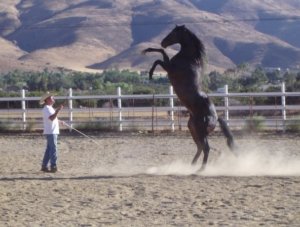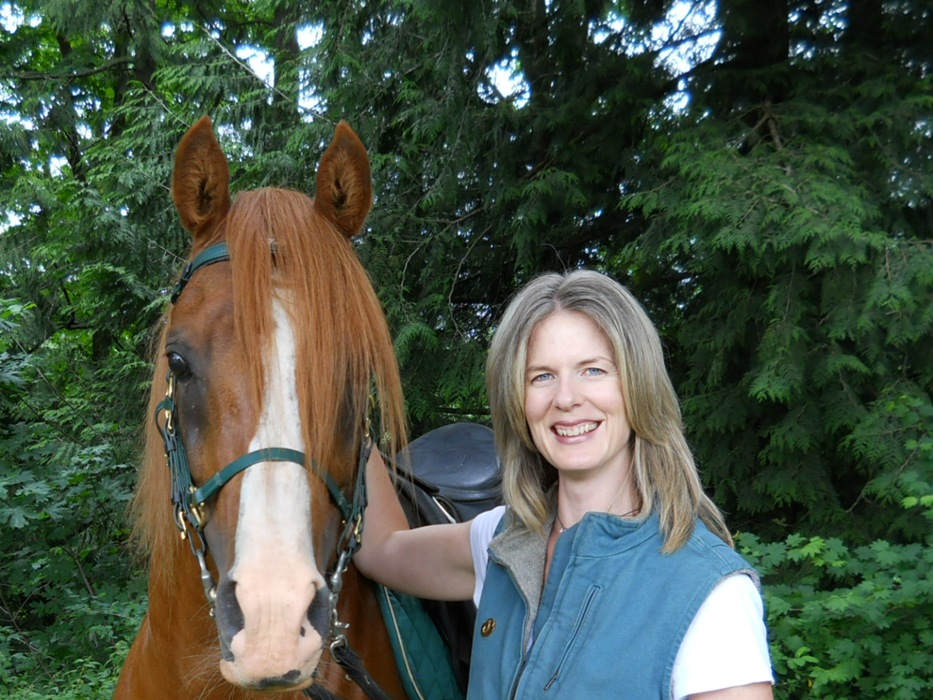Behind the Scenes of This Epic Film With Hollywood Horse Trainer Bobby Lovgren
by Catherine Madera and Bobby Lovgren
Film information courtesy of DreamWorks Pictures
 On December 28, DreamWorks Pictures will bring the remarkable film War Horse to audiences everywhere. Director Steven Spielberg’s epic adventure is a tale of loyalty, hope, and tenacity set against a sweeping canvas of rural England and Europe during the First World War. War Horse begins with the remarkable friendship between a horse named Joey and a young man called Albert, who tames and trains him. When they are forcefully parted, the film follows the extraordinary journey of the horse as he moves through the war, changing and inspiring the lives of all those he meets—British cavalry, German soldiers, and a French farmer and his granddaughter—before the story reaches its emotional climax in the heart of No Man’s Land.
On December 28, DreamWorks Pictures will bring the remarkable film War Horse to audiences everywhere. Director Steven Spielberg’s epic adventure is a tale of loyalty, hope, and tenacity set against a sweeping canvas of rural England and Europe during the First World War. War Horse begins with the remarkable friendship between a horse named Joey and a young man called Albert, who tames and trains him. When they are forcefully parted, the film follows the extraordinary journey of the horse as he moves through the war, changing and inspiring the lives of all those he meets—British cavalry, German soldiers, and a French farmer and his granddaughter—before the story reaches its emotional climax in the heart of No Man’s Land.
The First World War is experienced through the journey of this horse—an odyssey of joy and sorrow, passionate friendship, and high adventure. War Horse is one of the great stories of friendship and war. A successful book, it was turned into a hugely successful international theatrical hit that is arriving on Broadway next year. It now comes to screen in an epic adaptation by one of the great directors in film history.
What does it take to prepare the equine cast of characters for such a film? The NWHS caught up with Head Wrangler for the movie Bobby Lovgren for an inside look at the making of War Horse and the life of a Hollywood horse trainer.
What is your background as a horse trainer—formal or informal training?
I grew up riding jumping and dressage horses. My parents own a large riding school in South Africa. We also did commercials and films there. When I came to America I was fortunate enough to meet Glenn Randall and apprentice for him. The base that I was taught from Glenn also enabled me to train reined cow horses, which I showed at the Snaffle Bit Futurity.
How did you become a Hollywood horse trainer?
I apprenticed for Glenn Randall, a world renowned trainer known for his work in Ben Hur and training Roy Rogers’ Trigger, as well as many other projects. His son Corky Randall started using me as a trainer in the film industry here. Corky also had many projects including The Black Stallion films. With both of their experience and knowledge being passed on to me, it was a great foundation to learn from which enabled me to continue improving my training.
Any favorite horsemen past or present who were/are an inspiration?
Glenn and Corky Randall, both great horsemen who have since passed away, were a great inspiration to me. In addition, Ted Robinson was a tremendous help to me in my reined cow horse adventure.
What films have you worked on?
Some of the most recent films I have done are War Horse, Snow White, The Legend of Zorro, Racing Stripes, Sea Biscuit, Mask of Zorro, and an ABC Family TV series called Wildfire.
How did War Horse compare to other movies—unique challenges, etc?
Working with Steven Spielberg as a Director and the producers, who had also been a part of some very big films, was such an honor and a bit intimidating in the beginning. War Horse from the start was a much bigger film in the sense that you could feel that it was going to be an epic movie, so I knew I had to do all that I could to transfer Mr. Spielberg’s vision to film. A lot of preparation was put into training the horses to perform in and around war sequences, which were obviously make believe, but we still had to create the appearance of panic and nervousness from our animal actors without having them actually be scared. In addition, there was a collaboration of trainers from different countries and backgrounds, so as Horsemaster and Head Trainer on the film it was important to be able to communicate and get the best out of all of the people involved in our department.
Tell us about the equine star(s) of War Horse—breed, gender, personality?
One of the stars of War Horse is my horse Finder, a thoroughbred gelding. He was the only horse flown to England from the U.S. He is a very special horse that has a lot of personality and shows a lot of emotion when he works. Every equine actor involved with War Horse did a fantastic job from the young foals, the plow horses, the actors’ riding horses, as well as all of our background cavalry horses. Each and every horse was just as important as the others in bringing something special to the screen, there really wasn’t just one “star”. I am truly grateful for having Finder there because he was our back up in all situations if something changed or was too difficult for some of our other specialty horses that were not as experienced on set. Because of my close relationship with Finder and his trust in me, I was able to achieve some very difficult and emotional sequences. In one scene our hero horse tries to pull his horse friend up by the reins. This was a very emotional scene and very touching. Finder is very good at retrieving or pulling things with his mouth, and this made the scene much easier for me to accomplish.
How many horses were used on the set and what specific training was needed (when do you begin working with the horses, etc.)?
There were many different horses used because the film follows the horse from a foal through his adult life. Approximately 10 hero horses were used and sometimes more were needed. The other horses were mostly Andalusians and a few Warmbloods. In a typical film we have about 3 months of prep to get the horses ready for filming. For War Horse every age of horse that we used had to work at liberty, meaning free of any restraint. The older horses had to work at liberty and interact with the actors. We also had to train all of the horses to interact with other horses that they might meet in the film and show different emotions and reactions to different situations.
Describe “A Day in the Life of a Hollywood Horse Trainer” while working on set
The most demanding thing about working on a film as a trainer is not training the animal, but rather working with the crew, understanding how the filming is going to take place, knowing where to stand to be out of the shot and get the best performance from my animal actors. Communicating with the Director or the First Assistant Director is of the utmost importance to understand their needs for the film or to convey my animal’s needs in order to get the best performance from my horse. A trainer’s day starts earlier than some of the people on set as I have to have the animal actors ready and rehearsed for the scenes coming up. If an actor is going to be riding a horse, I have to be sure that horse has been properly warmed up. In addition, there are often changes to scenes, and therefore being able to pick the correct animal actor for the scene is critical. That is one of the reasons why we never do any film with just one horse. Just like people, horses can have a bad day, so it is important to realize that and be prepared to make adjustments.
Do you ride for pleasure and, if so, what sort of riding do you do?
I enjoy riding and training reined cow horses, but don’t have the time to do that very much anymore.
What do you hope movie goers take away from War Horse?
I hope people can see the hard work that went in to getting all of the emotions out of the horses from everyone involved in working on the film.
Bio: I have been in the movie industry for about 20 years. I live in Southern California with my wife and kids. When I am not away on a film, I enjoy taking my boys motocross racing and hope to be watching THEM on TV one day.
Find more information about the film at www.warhorsemovie.com or on Facebook: facebook.com/WarHorseMovie.
Published December 2011 Issue

Catherine Madera served as editor of the Northwest Horse Source for five years. She has written for numerous regional and national publications and is a contributing writer for Guideposts Magazine and the author of four equine-related books. She has two grown children and lives with her husband and three horses in Northwest Washington.






